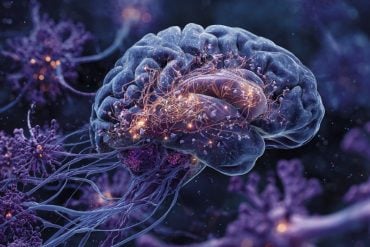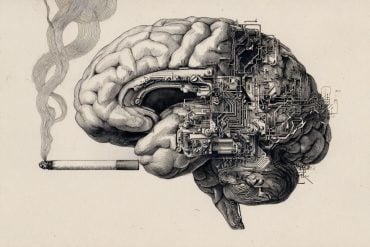Summary: Researchers have developed a robot capable of playing a game of Tic-Tac-Toe. The robot can interact with patients in rehabilitation to help improve their motor skills.
Source: Ben-Gurion University of the Negev.
Researchers from Ben-Gurion University of the Negev (BGU) in Beer-Sheva, Israel have demonstrated for the first time the feasibility of a robotic system that plays Tic Tac Toe with rehabilitation patients to improve real-life task performance.
The interdisciplinary research team designed a game with a robotic arm to simulate “3D Functional Activities of Daily Living”–actions people undertake daily, like drinking from a cup, that are often a focus of rehabilitation.
Designing a social robot to help rehabilitate a patient is a new field which requires much research and experimentation in order to determine the optimal conditions. The research was published in Restorative Neurology and Neuroscience.
“Playing Tic Tac Toe with a set of cups (instead of X’s and O’s) is one example of a game that can help rehabilitate an upper limb,” says Dr. Shelly Levy-Tzedek of BGU’s Department of Physical Therapy, and Zlotowski Center for Neuroscience. “A person can pick up and place many cups while enjoying a game and improving their performance of a daily task.”
Researchers compared study participants’ motivation to play with a robot vs. a set of computer-controlled LED lights to determine the importance of interacting with an actual physical robot.

They tested the system on 62 healthy right-handed people from two age groups: 40 young adults around 25 years old (23 women and 17 men) and 22 older adults around 75 years old (10 women and 12 men). Both groups preferred the robotic system over the LED lights system. The older adults said it was more human-like, while the young adults reported the robot “was more interesting, fun and appealing.”
When asked which partner they would prefer to play two additional games with, both groups selected the robotic system over the lights. However, when asked to play an additional 10 games, the older adults still preferred the robot, but the young group preferred to play against the LED lights system.
“Some of the young adults complained that the robot moved too slowly; therefore, they preferred the quicker system when asked to play many more games,” says Dr. Levy-Tzedek. “That indicates a need to personalize the speed of the robot to each participant.”
An unexpected finding was that the robot’s movement influenced human movement. Both young and older adults moved significantly slower when they played with the slower robot compared to the faster lighting system.
These results indicate that people are willing to continue to interact with a robotic device in a social-like setting, and that embodiment plays an important role, which is a positive sign for the future of such systems. Now that they have established feasibility, the researchers recommend testing their system on rehabilitating stroke victims.
The research was led by Dr. Danny Eizicovits, a BGU postdoctoral fellow co-advised by Dr. Shelly Levy-Tzedek of the BGU Department of Physical Therapy and the Zlotowski Center for Neuroscience, Prof. Yael Edan of the Department of Industrial Engineering and Management, and Prof. Iris Tabak of the Department of Education.
Funding: The research was partially supported by the Helmsley Charitable Trust, BGU’s Agricultural, Biological and Cognitive Robotics Initiative and the Marcus Endowment Fund, as well as the Rabbi W. Gunther Plaut Chair in Manufacturing Engineering. Additional funding was provided by the Brandeis Leir Foundation, the Brandeis Bronfman Foundation, the Promobilia Foundation, the Borten Family Foundation, the Planning and Budgeting Committee I-CORE Program, and The Israel Science Foundation (ISF) (1716/12) through the Learning in a Networked Society (LINKS) center and grants number 535/16 and 2166/16.
Source: Andrew R Lavin – Ben-Gurion University of the Negev
Publisher: Organized by NeuroscienceNews.com.
Image Source: NeuroscienceNews.com image is credited to Ben-Gurion University.
Video Credit: Video credited to
Ben Gurion University.
Original Research: Open access research for “Robotic gaming prototype for upper limb exercise: Effects of age and embodiment on user preferences and movement” by Eizicovits, Danny; Edan, Yael; Tabak, Iris; and Levy-Tzedek, Shelly in Restorative Neurology and Neuroscience. Published March 8 2018.
doi:10.3233/RNN-170802
[cbtabs][cbtab title=”MLA”]Ben-Gurion University of the Negev”First Robotic System Plays Tic-Tac-Toe to Improve Task Performance.” NeuroscienceNews. NeuroscienceNews, 4 May 2018.
<https://neurosciencenews.com/tic-tac-toe-robot-8968/>.[/cbtab][cbtab title=”APA”]Ben-Gurion University of the Negev(2018, May 4). First Robotic System Plays Tic-Tac-Toe to Improve Task Performance. NeuroscienceNews. Retrieved May 4, 2018 from https://neurosciencenews.com/tic-tac-toe-robot-8968/[/cbtab][cbtab title=”Chicago”]Ben-Gurion University of the Negev”First Robotic System Plays Tic-Tac-Toe to Improve Task Performance.” https://neurosciencenews.com/tic-tac-toe-robot-8968/ (accessed May 4, 2018).[/cbtab][/cbtabs]
Abstract
Robotic gaming prototype for upper limb exercise: Effects of age and embodiment on user preferences and movement
Background:
Effective human-robot interactions in rehabilitation necessitates an understanding of how these should be tailored to the needs of the human. We report on a robotic system developed as a partner on a 3-D everyday task, using a gamified approach.
Objectives:
To: (1) design and test a prototype system, to be ultimately used for upper-limb rehabilitation; (2) evaluate how age affects the response to such a robotic system; and (3) identify whether the robot’s physical embodiment is an important aspect in motivating users to complete a set of repetitive tasks.
Methods:
62 healthy participants, young (<30 yo) and old (>60 yo), played a 3D tic-tac-toe game against an embodied (a robotic arm) and a non-embodied (a computer-controlled lighting system) partner. To win, participants had to place three cups in sequence on a physical 3D grid. Cup picking-and-placing was chosen as a functional task that is often practiced in post-stroke rehabilitation. Movement of the participants was recorded using a Kinect camera.
Results:
The timing of the participants’ movement was primed by the response time of the system: participants moved slower when playing with the slower embodied system (p = 0.006). The majority of participants preferred the robot over the computer-controlled system. Slower response time of the robot compared to the computer-controlled one only affected the young group’s motivation to continue playing.
Conclusion:
We demonstrated the feasibility of the system to encourage the performance of repetitive 3D functional movements, and track these movements. Young and old participants preferred to interact with the robot, compared with the non-embodied system. We contribute to the growing knowledge concerning personalized human-robot interactions by (1) demonstrating the priming of the human movement by the robotic movement – an important design feature, and (2) identifying response-speed as a design variable, the importance of which depends on the age of the user.







